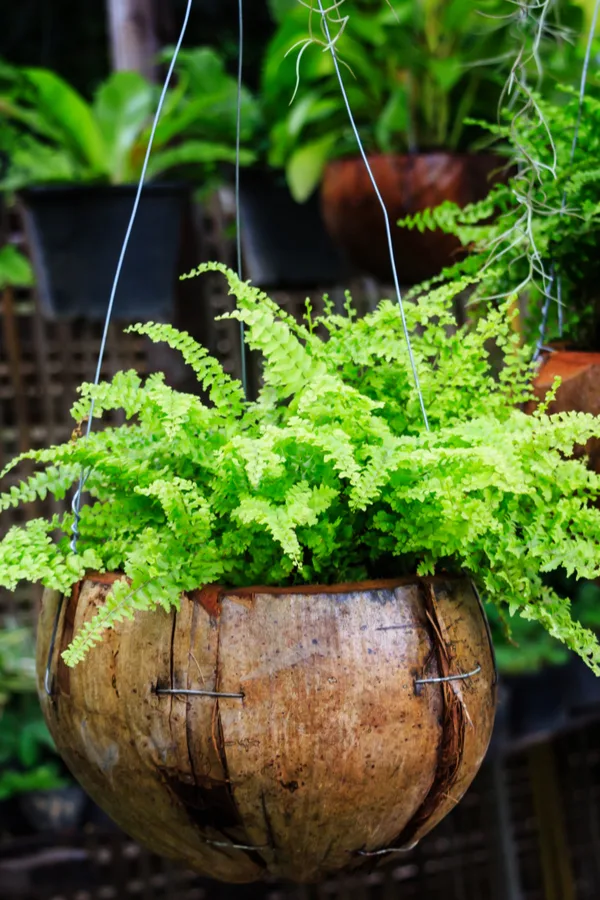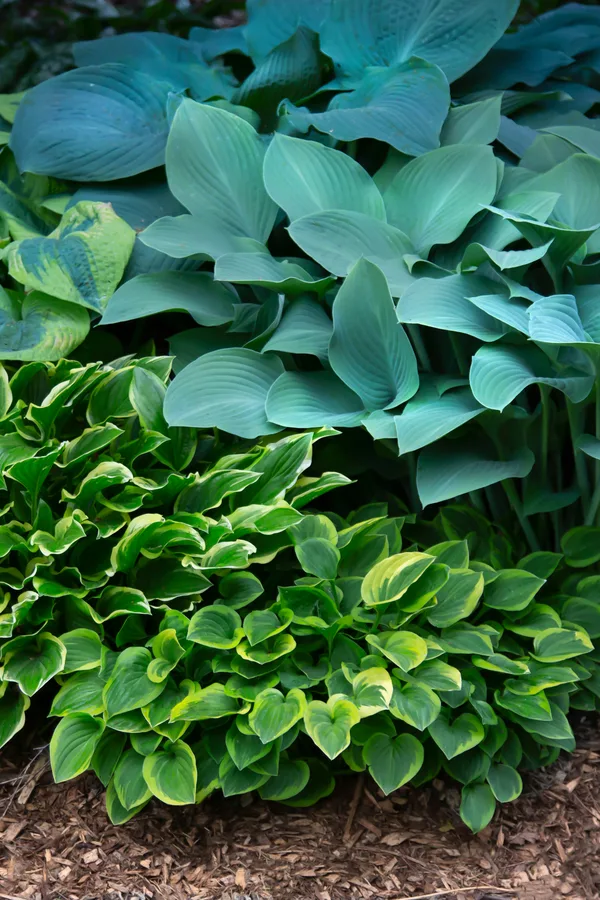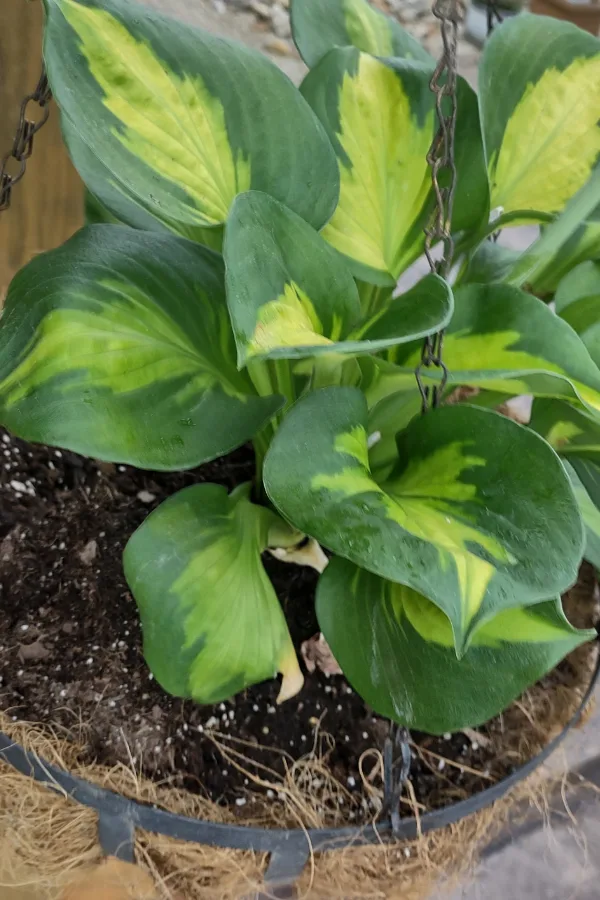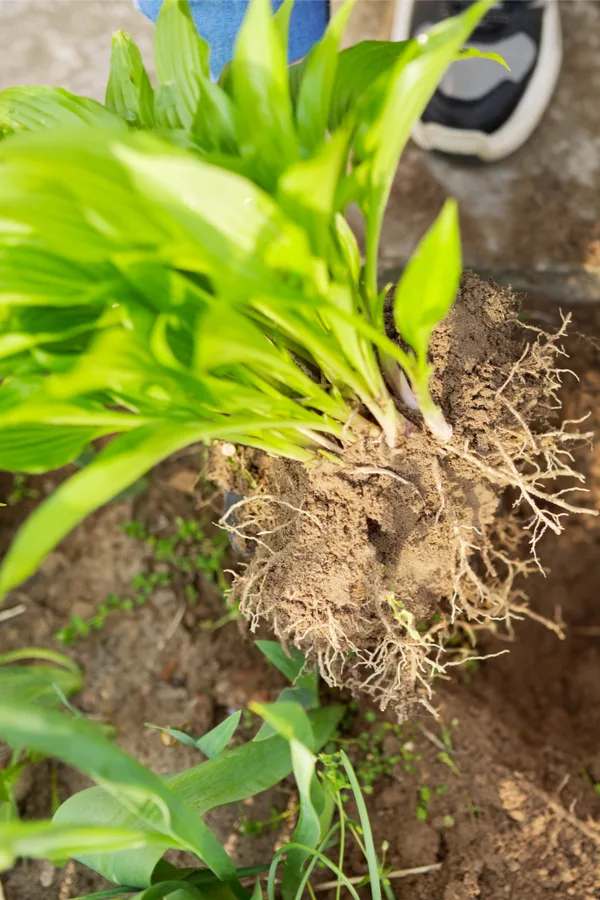If you are looking for a great way to save money and have beautiful hanging planters for a shady porch or outdoor living space – you need to try creating a few hanging baskets from hostas!
When it comes to the shadier spots of your landscape, the choices for hanging basket plants are fairly limited. Especially if you are looking a plant to keep alive to use again, year after year.
There is of course, the Boston fern. With it’s stately green fronds, the fern is by far the standard choice for adding greenery to locations that receive little sun.

But ferns do have a few drawbacks. For one, in most climates, they need to be overwintered indoors in order to keep alive from year to year. In addition, many grow so fast, they need to be split and divided yearly just to keep them fitting in a basket.
And finally, although they do provide ultra-green foliage, ferns don’t exactly light up a space with interesting color and contrast.
In fact, let’s face it it, ferns can get a bit boring when placed in the same space, year after year. And that is exactly where hostas come to the rescue!
The Simple Beauty Of A Hosta – How To Create Hanging Baskets from Hostas
It’s well known that hostas are the ultimate shade-loving perennial. The gorgeous plants have long been a wondrous choice for filling shaded flowerbeds with their stunning large-leafed foliage. And does that foliage ever come in a staggering array of colors and designs!

Hostas are available in hundreds of varieties, from solid green, blue, yellow and white, to variegated versions with a whole slew of different striping patterns. In fact, the selection is so diverse it can be overwhelming picking your favorite!
With all of that beauty, it’s easy to see why they are such a favorite for flowerbeds. But it just so happens that these leafy perennials also perform equally well in pots and containers. And even better, in hanging baskets too!
Why Hostas Are Perfect For Hanging Baskets – Creating Hanging Baskets from Hostas
With their stunning large-leaf foliage, hostas are a unique alternative from more traditional shade-loving hanging basket plants. With leaves that naturally spill down over the sides from their own weight, they fill out baskets quickly.

Even better, hostas require very little nutrients from the soil. That means there is little need for special potting soil or fertilizing to keep them growing strong. In addition, as a perennial, they also require less frequent watering than a typical hanging planter.
But perhaps best of all, hostas are an extremely economical choice for creating shade-loving hanging basket planters. In fact, in many cases, as you will see below, you can create them for free, year after year!
How To Plant Hostas In Baskets – Creating Hanging Baskets from Hostas
There are two easy and inexpensive ways to create hanging basket planters from hostas. The first is by purchasing smaller sized hosta plants at your local nursery or garden centers.
Many garden centers carry smaller, 1 quart or even half-gallon hosta plants for well under $10. Considering many flowering baskets can go for $40 or more, it’s quite the bargain. Especially when you consider you can keep the plants from year to year!

Planting is as easy as adding a bit of potting soil and compost in the basket, and placing the transplant down into the soil. Fill around the edges of the basket with additional potting soil, and your hosta planter is ready to go!
When planting store-bought transplants, don’t be afraid to break the roots apart a bit to allow them to fit down into the basket. Hostas are actually quite hardy and durable, and the roots will re-establish quickly in the surrounding soil.
Purchasing small transplants is not only economical, but a great way to add to your hosta collection. And by year’s end, the plants are usually large enough to divide into even more to use in your flowerbeds as well.
Using Existing Hostas – Creating Hanging Baskets From Hostas
The second method for creating hanging basket planters is to use existing plants already in your landscape. If creating in early spring, simply dig up the crown of an existing plant and plant into a basket.

Spring is ideal because if the roots are too large, you can divide enough to fill several baskets. And dividing can even give you additional plants to put back into the landscape.
Although spring is the ideal time to create hanging baskets from hostas, you can also create them in early to mid summer from existing oversized plants. (See : How To Divide Perennials In The Summer)
Begin by digging up the plants and splitting into sizable portions that will fit into baskets. Plant the roots in the same method, but cut back the foliage to about an inch above the surface level and keep well watered.
Don’t worry, the foliage will brown off, but the plant won’t die off. In fact, It’s quite surprising how quickly new foliage will spring up from the roots at the base. Within a few weeks, your new shade loving basket will begin to fill out!
Caring For Hostas In A Hanging Basket Planter
Caring for your baskets through the summer couldn’t be easier. Even though you will still need to water plants on a regular basis, you will notice they are not as needy as traditional annual flowering plants.

Although fertilizing is not necessary, a bit of compost tea once a month will help keep the foliage strong and vibrant. Most hosta plants will still set blooms when growing in hanging baskets. You can leave the blooms in place to enjoy, but removing will help to keep more energy for stronger foliage.
Fall Care
The best part of using hostas as hanging basket plants is reusing them year after year. As fall approaches, simply remove the hostas from their pots and place into the ground to overwinter.
Unlike other shade favorites like ferns, there is no need to bring them indoors to save. Next spring, you can either leave in the landscape, or dig back up to create more baskets planters for the new season. Talk about saving money and adding big color to shady porches!
For more on hosta care, be sure to check out our article “How To Keep Hostas Healthy All Summer Long”on the blog. Here is to creating a few shade -loving hanging baskets from hostas this summer!
This Is My Garden is a website dedicated to spreading the love and knowledge of gardening around the world. We publish two new garden articles each week. This article may contain affiliate links.
